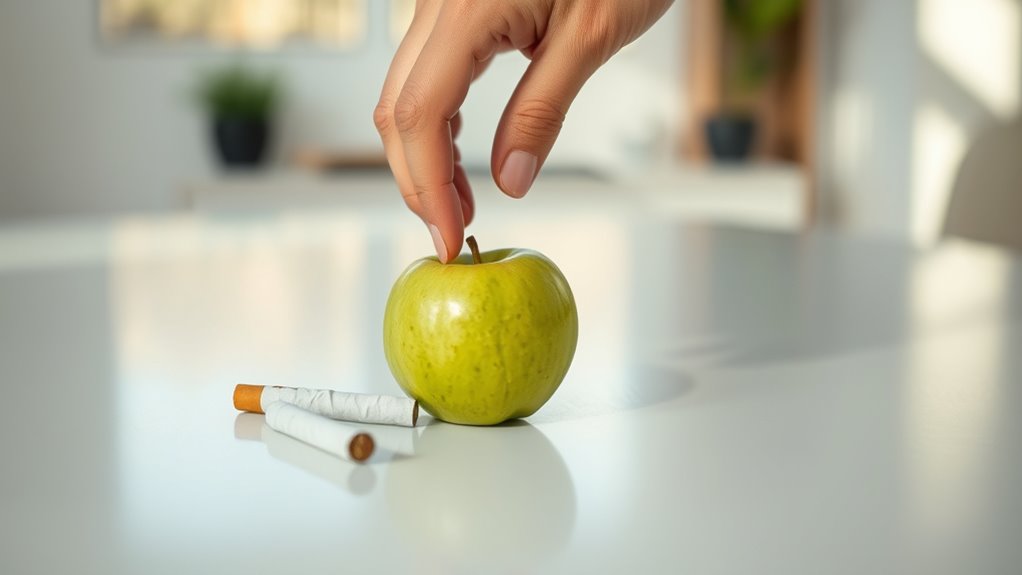To replace unwanted behaviors, start by identifying your triggers and routines. Use mindful awareness to recognize cues that prompt bad habits, then intentionally practice healthier alternatives until they become automatic. Choose simple activities that fulfill the same emotional needs and reinforce them consistently. Support your efforts by tracking progress, celebrating small wins, and adjusting your environment to reduce temptations. Keep exploring these strategies to learn how you can effectively transform habits and create lasting change.
Key Takeaways
- Recognize triggers and environmental cues that prompt unwanted behaviors to facilitate targeted substitution strategies.
- Choose healthier, meaningful activities that fulfill the same emotional needs as the unwanted behavior.
- Practice mindfulness to increase awareness of urges and create intentional routines for replacement behaviors.
- Support habit change by removing triggers and reinforcing new behaviors through consistency and positive reinforcement.
- Track progress and celebrate small wins to maintain motivation and ensure long-term success in replacing habits.
Understanding the Power of Habit Substitution

Understanding the power of habit substitution begins with recognizing that habits are deeply ingrained behaviors rooted in our routines. When you develop mindful awareness, you become more conscious of the environmental cues that trigger your unwanted habits. These cues—like a certain time of day, a location, or an emotional state—prompt automatic responses. By observing these triggers without judgment, you can start to see how habits form and persist. This awareness gives you the power to intentionally replace an automatic response with a healthier one. Instead of reacting impulsively, you can choose a different behavior that aligns with your goals. Recognizing the influence of environmental cues and practicing mindful awareness is essential for successfully substituting unwanted habits with positive alternatives. Developing emotional regulation skills can further support your efforts in replacing negative behaviors with constructive ones.
Identifying Your Unwanted Behaviors

Recognizing which behaviors you’d like to change is the first step toward effective habit substitution. To do this, develop your emotional awareness through mindfulness training. Pay attention to when and why unwanted behaviors occur. Keep track of triggers, feelings, and situations that prompt these actions. This awareness helps you spot patterns and underlying causes. Use the table below to identify common unwanted behaviors and their emotional triggers:
| Unwanted Behavior | Emotional Trigger | Situations/Situations |
|---|---|---|
| Nail biting | Anxiety | Stressful meetings |
| Snacking excessively | Boredom | Watching TV |
| Procrastinating | Overwhelm | Deadlines approaching |
| Interrupting others | Frustration | Conversations |
Being mindful of these patterns allows you to target specific behaviors for substitution. Recognizing paint sprayer types and their performance metrics can also support your efforts by helping you select the most suitable tools for task completion, thereby reducing frustration and increasing success.
Choosing Effective Replacement Activities

Once you’ve identified the unwanted behaviors and their triggers, the next step is to select effective replacement activities that fulfill the same emotional needs without the negative consequences. Use mindful awareness to assess what you truly need—whether comfort, distraction, or connection—and choose activity alternatives that meet those needs healthily. For example, if you tend to snack impulsively when stressed, consider a quick walk or deep breathing instead. Focus on activities that keep you engaged and bring a sense of accomplishment or calm. The key is to pick replacements that are realistic and satisfying, making it easier to break old habits and establish new, positive patterns. Incorporating soothing routines like applying eye patches can also serve as a calming ritual that helps you unwind and refocus. By consciously choosing these alternatives, you reinforce your ability to control triggers and foster lasting change.
The Science Behind Habit Formation and Change

Habit formation occurs through the brain’s process of creating and strengthening neural pathways, making behaviors automatic over time. Neuroplasticity research shows that your brain adapts by rewiring itself based on repeated actions, which solidifies habits. When you perform a behavior, dopamine influences your brain’s reward system, reinforcing the action and motivating you to repeat it. This chemical response explains why habits become ingrained and hard to break. To change a habit, you need to disrupt this cycle, creating new pathways that eventually override old ones. Understanding how neuroplasticity works highlights that the brain is adaptable, not fixed. By leveraging dopamine’s role in reinforcement, you can gradually rewire your habits and develop healthier behaviors, making lasting change achievable. Additionally, engaging in positive reinforcement techniques can enhance the effectiveness of your efforts to establish new, beneficial habits.
Tips for Successfully Implementing Habit Substitution

Implementing habit substitution successfully requires strategic planning and consistency. Start by cultivating mindful awareness of your triggers and routines, so you can identify when your unwanted behavior occurs. This awareness helps you recognize environmental cues that prompt your habits, allowing you to modify or avoid them. Choose a substitute behavior that’s simple, accessible, and meaningful, ensuring it aligns with your goals. Reinforce your new habit by intentionally practicing it whenever you notice the cues, gradually replacing the old behavior. Keep your environment supportive—remove triggers for the unwanted habit and create reminders for your new one. Proper planning can help you avoid costly errors and maximize benefits. Consistency is key; over time, these deliberate actions will rewire your routines and make positive change more sustainable.
Common Challenges and How to Overcome Them

While habit substitution can be highly effective, it often comes with common challenges that can hinder your progress. Peer resistance is a significant obstacle; friends or colleagues might encourage old habits or dismiss your efforts, making it harder to stay committed. Emotional triggers also pose a threat, as stress, boredom, or anxiety can lead you back to unwanted behaviors. To overcome peer resistance, communicate your goals clearly and seek support from understanding individuals. When emotional triggers strike, develop alternative coping strategies like deep breathing or mindfulness to manage your feelings without reverting. Recognizing these challenges early helps you prepare and stay focused on your replacement habits, ensuring you don’t get sidetracked by external influences or emotional setbacks. Additionally, being aware of for sale 100 can provide motivation and resources to support your behavioral changes.
Tracking Your Progress and Staying Motivated

Keeping track of your daily achievements helps you see how far you’ve come and stay focused on your goals. Celebrating small wins boosts your motivation and reinforces positive habits. By monitoring your progress, you’ll find it easier to stay committed to your habit substitution journey. Incorporating cultural breakfast traditions can also inspire new healthy routines that keep your mornings interesting.
Monitoring Daily Achievements
How can you stay motivated and on track when working toward a new habit? Monitoring your daily achievements is key. Use reward systems to celebrate small successes, which reinforce your progress and keep your momentum high. Track your accomplishments by noting when you successfully respond to habit triggers, making it easier to recognize patterns and stay focused. Regularly reviewing your progress helps you see how far you’ve come, boosting your confidence. Avoid relying solely on motivation; instead, develop a system that rewards consistent effort and aligns with your goals. By consciously monitoring your achievements each day, you create a sense of accountability that propels you forward. Staying aware of your progress keeps the habit substitution process clear, manageable, and motivating. Recognizing the importance of self-awareness can further enhance your capacity to maintain new behaviors effectively.
Celebrating Small Wins
Celebrating small wins is a powerful way to stay motivated and reinforce your progress. Recognizing each achievement helps you see how far you’ve come and fuels your commitment. Reward recognition, even for minor milestones, boosts your confidence and keeps you focused. Milestone celebrations remind you that change doesn’t happen overnight, but each step counts. Use the table below to plan your celebrations:
| Achievement Level | Celebration Ideas |
|---|---|
| Small Step | Treat yourself to a favorite snack |
| Midway Milestone | Share your success with a friend |
| Major Milestone | Plan a special activity or purchase |
| Goal Reached | Reflect and reward yourself fully |
Tracking progress and celebrating small wins makes your journey enjoyable and sustainable. Incorporating music therapy techniques into your routine can further enhance your motivation and emotional well-being.
Real-Life Examples of Successful Habit Replacement

Many people have successfully replaced unwanted habits by substituting them with healthier or more productive behaviors. For example, someone quitting smoking might practice mindful awareness to recognize triggers and cravings, making it easier to choose a different action. Social support also plays a pivotal role; sharing goals with friends or joining support groups keeps you motivated and accountable. One individual replaced late-night snacking by drinking water and engaging in a relaxing activity like reading, which shifted their routine. Another person used mindful awareness to notice the urge to procrastinate and replaced it with a quick walk to clear their mind. Additionally, leveraging professional services to develop tailored strategies can enhance the effectiveness of habit substitution. These real-life stories demonstrate that with conscious effort, support, and awareness, habit substitution leads to lasting change.
Tools and Resources to Support Your Journey

To effectively support your habit substitution efforts, leveraging the right tools and resources can make a significant difference. Mindfulness exercises help you stay aware of triggers and manage cravings, making it easier to replace unwanted behaviors. Accountability partners provide encouragement and keep you motivated, offering external support when challenges arise. Using apps for tracking progress or guided meditation can also reinforce your commitment. Here’s a quick look at some useful tools:
| Tool/Resource | Benefit |
|---|---|
| Mindfulness exercises | Increase awareness and reduce impulsive behaviors |
| Accountability partners | Offer support, motivation, and accountability |
| Habit-tracking apps | Monitor progress and identify patterns |
| Guided meditations | Enhance focus and emotional regulation |
| Educational books and courses | Provide insights and strategies for change |
Maintaining New Habits for Long-Term Success

Once you’ve established your new habits with the right tools and resources, maintaining them over the long term becomes the next challenge. To do this, practice mindful awareness to stay present and recognize when old habits or environmental cues trigger unwanted behaviors. By paying attention to these cues, you can consciously choose to reinforce your new habits instead. Adjust your environment to support your goals—remove temptations and introduce cues that remind you of your intentions. Consistency is key; revisit your motivations regularly and celebrate small wins. Over time, mindful awareness helps turn new behaviors into automatic routines. Staying vigilant and mindful ensures your habits become lasting parts of your daily life, increasing your chances of long-term success.
Frequently Asked Questions
How Long Does It Typically Take to Replace a Habit?
When you wonder how long it takes to replace a habit, remember that habit formation varies from person to person. On average, it takes about 21 to 66 days for behavior change to become automatic, but some habits may take longer. Consistency is key, and replacing unwanted behaviors with positive ones helps solidify new routines. Stay patient and committed, and you’ll see progress over time.
Can Habit Substitution Work for Deep-Rooted or Addictive Behaviors?
They say “old habits die hard,” but habit substitution can work for deep-rooted or addictive behaviors if you understand emotional triggers and environmental cues. You can replace a harmful behavior with a healthier one by identifying what sparks the urge. Consistency helps, and over time, the new habit can weaken the old. While tough, persistence and awareness can help you rewire your responses, making lasting change possible.
How Do Emotions Influence Habit Substitution Success?
Emotions play a big role in habit substitution success because emotional triggers often prompt unwanted behaviors. When your mood is unstable, it’s harder to stay committed to change. You need to focus on mood regulation, recognizing emotional cues, and finding healthier ways to cope. By managing your emotions, you create a more stable foundation, making it easier to replace old habits with positive ones and maintain long-term progress.
Are There Specific Times of Day Better for Habit Replacement?
Timing strategies matter more than you think; morning or evening, your energy levels and routines influence success. You might find mornings ideal if you’re energetic and focused, while evenings could work if you prefer winding down. By aligning habit replacement with your daily routines, you create consistency. Pay attention to when you feel most motivated or least distracted, and tailor your approach accordingly for better results.
How Can Social Support Enhance Habit Substitution Efforts?
Social support can considerably boost your habit substitution efforts. By engaging your social networks, you gain encouragement strategies that keep you motivated and accountable. When friends or family cheer you on, it becomes easier to stick with your new habits, especially during challenging times. Their encouragement helps reinforce your commitment, making it more likely you’ll replace unwanted behaviors successfully and develop lasting positive routines.
Conclusion
By mastering habit substitution, you could become unstoppable—transforming your life so dramatically that even superheroes would envy your newfound self-control. Every unwanted behavior replaced is a stepping stone to a future where you’re unstoppable, unstoppable, and totally in charge. Keep pushing, stay consistent, and watch as your habits reshape your destiny faster than you ever thought possible. The power to change is in your hands—grab it now and unleash your true potential!









